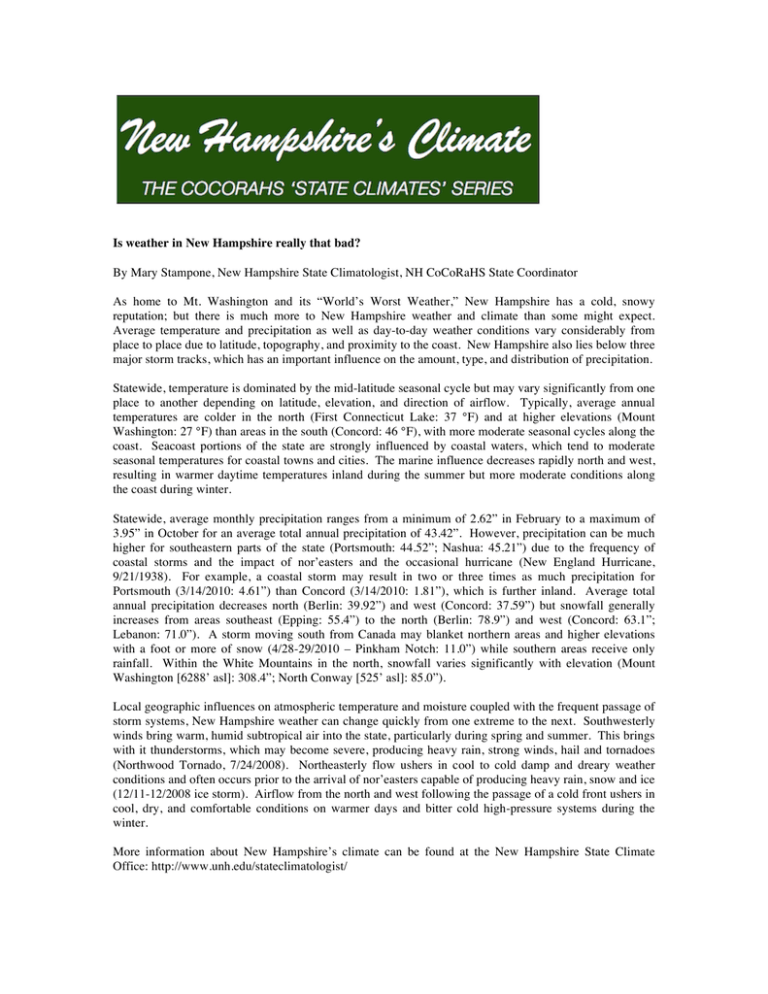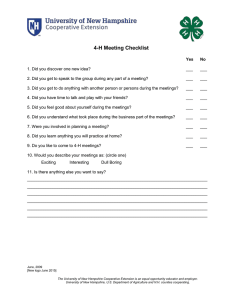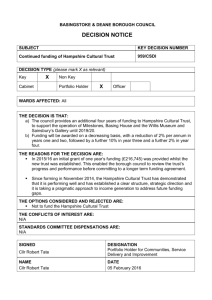Is weather in New Hampshire really that bad?
advertisement

Is weather in New Hampshire really that bad? By Mary Stampone, New Hampshire State Climatologist, NH CoCoRaHS State Coordinator As home to Mt. Washington and its “World’s Worst Weather,” New Hampshire has a cold, snowy reputation; but there is much more to New Hampshire weather and climate than some might expect. Average temperature and precipitation as well as day-to-day weather conditions vary considerably from place to place due to latitude, topography, and proximity to the coast. New Hampshire also lies below three major storm tracks, which has an important influence on the amount, type, and distribution of precipitation. Statewide, temperature is dominated by the mid-latitude seasonal cycle but may vary significantly from one place to another depending on latitude, elevation, and direction of airflow. Typically, average annual temperatures are colder in the north (First Connecticut Lake: 37 °F) and at higher elevations (Mount Washington: 27 °F) than areas in the south (Concord: 46 °F), with more moderate seasonal cycles along the coast. Seacoast portions of the state are strongly influenced by coastal waters, which tend to moderate seasonal temperatures for coastal towns and cities. The marine influence decreases rapidly north and west, resulting in warmer daytime temperatures inland during the summer but more moderate conditions along the coast during winter. Statewide, average monthly precipitation ranges from a minimum of 2.62” in February to a maximum of 3.95” in October for an average total annual precipitation of 43.42”. However, precipitation can be much higher for southeastern parts of the state (Portsmouth: 44.52”; Nashua: 45.21”) due to the frequency of coastal storms and the impact of nor’easters and the occasional hurricane (New England Hurricane, 9/21/1938). For example, a coastal storm may result in two or three times as much precipitation for Portsmouth (3/14/2010: 4.61”) than Concord (3/14/2010: 1.81”), which is further inland. Average total annual precipitation decreases north (Berlin: 39.92”) and west (Concord: 37.59”) but snowfall generally increases from areas southeast (Epping: 55.4”) to the north (Berlin: 78.9”) and west (Concord: 63.1”; Lebanon: 71.0”). A storm moving south from Canada may blanket northern areas and higher elevations with a foot or more of snow (4/28-29/2010 – Pinkham Notch: 11.0”) while southern areas receive only rainfall. Within the White Mountains in the north, snowfall varies significantly with elevation (Mount Washington [6288’ asl]: 308.4”; North Conway [525’ asl]: 85.0”). Local geographic influences on atmospheric temperature and moisture coupled with the frequent passage of storm systems, New Hampshire weather can change quickly from one extreme to the next. Southwesterly winds bring warm, humid subtropical air into the state, particularly during spring and summer. This brings with it thunderstorms, which may become severe, producing heavy rain, strong winds, hail and tornadoes (Northwood Tornado, 7/24/2008). Northeasterly flow ushers in cool to cold damp and dreary weather conditions and often occurs prior to the arrival of nor’easters capable of producing heavy rain, snow and ice (12/11-12/2008 ice storm). Airflow from the north and west following the passage of a cold front ushers in cool, dry, and comfortable conditions on warmer days and bitter cold high-pressure systems during the winter. More information about New Hampshire’s climate can be found at the New Hampshire State Climate Office: http://www.unh.edu/stateclimatologist/



